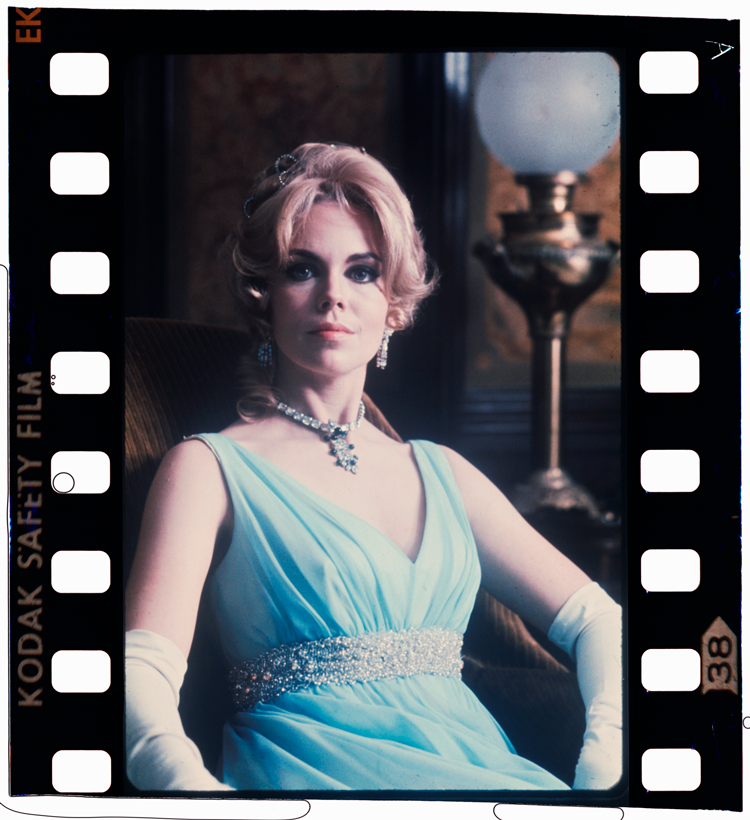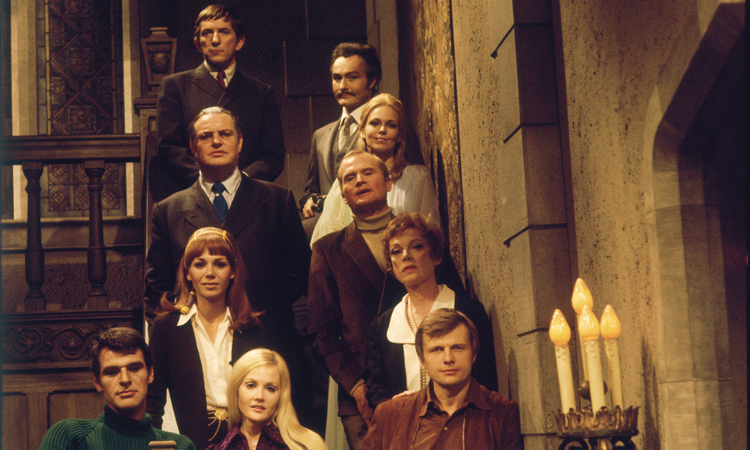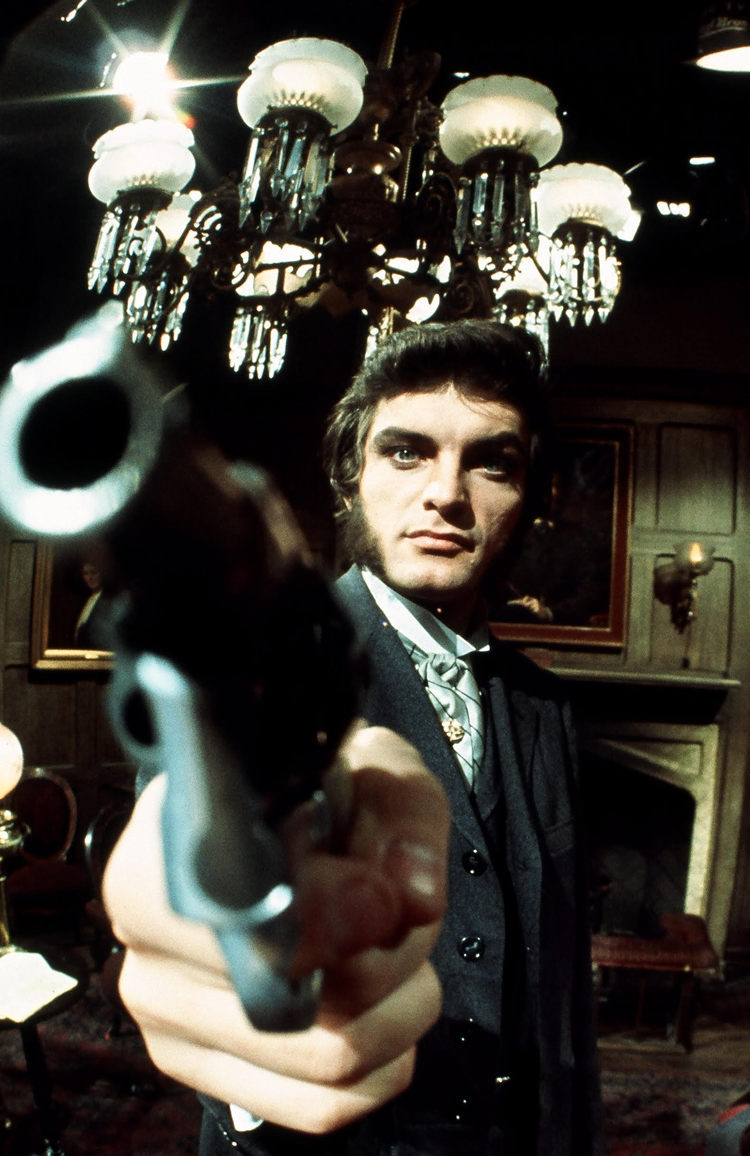In 1966, television producer Dan Curtis dreamt of a young woman on a train. From this simple beginning, a legend
was born. Writer Art Wallace developed Curtis’s vague idea into a 91-page series bible entitled Shadows On The Wall. This bible became a gothic soap opera, wherein slightly oddball orphan Victoria Winters (Alexandra Moltke) came to work in the town of Collinsport, for the charming yet unsettling Collins family, at the big old house of Collinwood, high atop Widows Hill. This was Dark Shadows.
Hollywood star Joan Bennett got top billing as Elizabeth Collins Stoddard, the loving but somewhat distant matriarch of the family. Her rather caddish brother Roger was played by Louis Edmonds, her daughter Carolyn by Nancy Barrett. Roger’s troubled son David, for whom Vicky was hired as a governess, was David Henesy. Rounding out the main cast were Kathryn Leigh Scott as waitress Maggie Evans and Mitchell Ryan as Burke Devlin, a local man with a vendetta against the Collins family. The show premiered in June 1966.
“There were no monsters when we started,” remembers Ryan. “It was a gothic melodrama, and very romantic.” The response from the viewers, however, was not great: “It was lukewarm. It wasn’t taking its time slot, that’s for sure.”
“The ratings weren’t wonderful, mainly because we were essentially doing a modern-day Jane Eyre,” Scott concurs. “All of the other soaps were doing these steamy plots about divorces and affairs and all of that sort of thing, and what we were doing was fairly staid.”
The appearance of a ghostly member of the Collins family heralded the turn towards straight-up supernatural drama, compounded by the introduction of David’s mother, a malicious Phoenix.
Seeing how successful the supernatural elements were, Curtis decided to introduce a new character, who would go on to define the show. According to Scott: “Dan Curtis, to save the show, came up with the idea – mainly because of his daughters – around Halloween, of bringing on a vampire.” Just under ten months after the show debuted, Jonathan Frid joined the cast as Barnabas Collins.
“When Jonathan came, the ratings doubled,” remembers Ryan. “That just astonished everyone, it was amazing.”
This full supernatural turn did take some getting used to: “I remember Joan Bennett saying: ‘Oh my God, goblins and ghosts?’” laughs Scott.
“Well, yeah, it was the butt of a joke,” says Ryan, “But soap operas are sort of the butt of a joke too. There was no way of turning back because it was incredibly popular.”
The success of Barnabas led to the show becoming a horror/sci-fi series, whilst retaining its soap opera style. Maggie Evans turned out to be the spitting image of Barnabas’ lost love Josette. “I went to the studio one day when I wasn’t working to pick up scripts. I saw Bob Costello, the producer, and June the costume woman wrestling with this clothes dummy that was dressed in ragged finery. They had a green light on her and she was on a dais and they were filming. They said it was the ghost of Josette, what do you think? I said: ‘I think it looks like a clothes dummy!’. They asked me if they would double for the clothes dummy, which I did. With the green light on me and the fan blowing my hair, it was terribly effective. Suddenly I had two roles.”
Barnabas’ history was explored, which led to the introduction of the lovesick witch Angelique, played by Lara Parker, who had cursed Barnabas in the first place.
“I didn’t really think it was such a great job being on a soap opera,” remembers Parker. “I wanted to be on Broadway! But when I got to the actual studio – we had our own studio on the Upper West Side – I was just thrilled because I’d done so many plays and it was a costume drama. We wore hairpieces and bustle dresses and eyelashes, and it was just like doing theatre. It was great fun, so I loved it.”

Over the next few years, the show saw Frankenstein-esque experiments to create life, wars with Lovecraftian creatures, and all manner of other ghastly monsters, with much flitting backwards and forwards (and sideways!) through time.
As with most soaps, the budget was low. The transition to colour in August 1967 particularly exposed some of the show’s shortcomings.
“I loved the black and white,” says Scott. “It’s really interesting, an awful lot of actors, Joan Bennett amongst them, I remember commenting that colour was a backwards step. I understood what they meant because there was something very real and haunting about the grittiness of black and white. Colour did make a difference.”
Throughout the show’s run, there were two primary directors, Lela Swift (who directed both the first and last episodes) and Henry Kaplan.
“Lela Swift was one of the very first women directors,” remembers Scott. “She was tough as nails on the outside, but she was just soft as a marshmallow! She was so caring and helpful to the young actors, like me, who had never been on television before. She could stand up to Dan Curtis, and he really looked to her as a mentor. As a matter of fact, he came on the show directing a couple of episodes under her tutelage before he directed the film, and turned into a remarkable film director. It was Lela Swift who showed him the ropes. We were incredibly lucky to have her.”
“You know, they were like my high school teachers,” remembers Parker. “I just strove so hard to please them. Henry Kaplan used to go around and give people grades. He had key words, like when you had a major realisation, and the music went DUN-DUN-DUUUN, he would say ‘transish!’. He wanted to see the awareness, the transition on your face. He would say: ‘If I don’t see something on your face, you’re not going to get your close-up!’. Then he’d come around after the show, open your dressing room door and say ‘B minus’ and slam your door. I never got an A from him. He kind of jostled us into trying to please him, to give him what he wanted. It’s not an easy thing to do, direct half an hour in one day. I had a great respect for them.”
“They were both pretty eccentric in their own ways,” adds Scott. “They were both characters, they were both larger than life. They were definitely the proper choice for our show!”
Original focal character Vicky disappeared with little fanfare, left trapped in the past. After Moltke left, two other actresses replaced her for brief stints, though neither were overly popular. Vicky was technically killed off, but the malleable nature of reality in the show means that many fans still believe her to be alive.
Before apparently dying in a plane crash, Burke Devlin was also recast. Mitchell Ryan describes the reason for his leaving candidly as “John Barleycorn”. “I was really behind the drink in those days,” he remembers. “It’s a shame because Dan and I were friends. We remained friends and he was very generous and quite lovely. A couple of years later I got to sober up and everything. It was unfortunate, that whole period of my life.”
Later introductions would include Quentin Collins, played by David Selby. Barnabas’ werewolf cousin became the show’s other heartthrob: “The show was a life-changer,” remembers Selby, “I had my own theme song!” Said theme song was the Grammy-nominated tune ‘Shadows of the Night (Quentin’s Theme)’, which featured Selby’s vocals, and is your new earworm. You’re welcome.
Understandably, given the need to produce five episodes a week, the recording schedule was punishing: “We started at 8am,” Selby remembers. “We had read the script around a table the day before (after taping was finished). We blocked the show and then put it up for the camera rehearsal. Then we taped it. It made for long days. At night we had to learn the next day’s script.”

Dark Shadows is frequently used as an example of gaffe-filled TV. “The bloopers were numerous,” acknowledges Parker. “There were mics coming into the shot, and prop men scurrying across the back behind us in the scene. So many things went wrong – not to mention the many times that actors went out and forgot their lines or said the wrong name… we were very under-rehearsed! But like everything else, we got used to it. We were all quick studies and young and enthusiastic, and we got used to it.”
The show came to an end in April 1971. Curtis went on to produce a large number of hugely successful TV and theatrical films, including The Night Stalker and Burnt Offerings, before managing to resurrect Dark Shadows in 1991. The revival only lasted one season, but is well-loved by a loyal fanbase. Another attempted revival was the 2004 pilot but sadly, despite a great cast and some well- done horror sequences, it was not picked up and the pilot remained unaired.
Kathryn Leigh Scott started a publishing company which has released a number of Dark Shadows books, including The Dark Shadows Companion, which celebrated the 25th anniversary of the show, and Dark Shadows: Return To Collinwood, which coincided with Tim Burton’s 2012 film.
Lara Parker wrote a novel giving more background to her character, Angelique’s Descent, in 1998. “I started writing and I just discovered that I had a kind of knack for doing this gothic romance. You know, it’s not literary fiction, it’s definitely genre. I just started thinking about my character’s childhood. She supposedly was born in Martinique, and we had actually taken several trips to the Caribbean. I tend to take notes when I’m inspired, and I’d taken a lot of notes about the fish and the shells and the areas that we sailed around, and so, as writers tend to do, I just started using my notes. I started writing about Angelique’s childhood and it just kind of came to me.”
Parker has subsequently written a number of novels within the Dark Shadows universe, most recently Heiress Of Collinwood in 2016.
Appropriately enough for a show where death was never really the end, Dark Shadows has also been resurrected on audio. In the first instance, many of the original cast were reunited in 2003 for Return To Collinwood, co-written by Selby’s son Jamison. First performed as a play at a convention, then recorded as an audio drama, Return sees characters gathering at Collinwood for the reading of Elizabeth’s will.
Audio producers Big Finish began releasing Dark Shadows full-cast audio plays and dramatic readings, starting with The House Of Despair in 2006. “Dark Shadows isn’t known over here [in the UK] that well,” says range co-producer Joe Lidster. “But it was shown in the Nineties on the SciFi Channel. A guy called Stuart Manning, who was working at Big Finish doing cover design – amazing designer –suggested they go for the licence. At the time Big Finish didn’t have a huge amount on aside from Doctor Who. I think it appealed to them to say: ‘Let’s go for an American thing, a different fanbase’.”
A large number of Dark Shadows alumni have returned to the series. “It’s fun to be doing just your voice,” says Parker. “My voice has deepened but not so much that you can’t recognise Angelique, apparently. You don’t have to be in make-up, you don’t have to do your hair, you just act for the microphone. It’s really fun to make the moment work with just your voice. I do very much enjoy doing them and they even let me write a story. They’re very very sweet people!”
Mitch Ryan returned to Dark Shadows for the first time in 48 years in…And Red All Over, opposite Kathryn Leigh Scott. “It’s a wonderful kind of a job, you just go in a recording booth and read it,” he says. “They were pretty good scripts, more up-to-date adventures.”
What is absolutely clear is that these audios are not mere fan-service. “We’re doing a continuation,” says Lidster. “In [2015’s 13-part serial] Bloodlust, we introduced two gay characters. If Dark Shadows was still being made in the Eighties, they would have introduced gay characters, because that’s what American soaps were doing at the time. The TV series is very white, it wouldn’t have been had it carried on. They would have become more socially aware. It’s not retelling stories from the TV series – we are continuing the TV series. Honestly, it’s a real honour to do.”
Dark Shadows’ legacy can be seen in the friendly vampires of Buffy The Vampire Slayer and The
Vampire Diaries, and the setup is mirrored in contemporary shows like Hemlock Grove. But the original classic isn’t going to be forgotten anytime soon…
“They have these autograph shows in LA and people come up with pictures of me in Dark Shadows,” says Ryan. “It’s amazing – things that hang on forever. Fans are quite extraordinary.”

What is it that has given Dark Shadows this amazing longevity?
“I think it must have been the investigation of the vampire,” suggests Ryan. “It’s an incredible folk horror story. You could see very clearly that it wasn’t doing very well and then, when the vampire came, it did a thousand times better. It had to be that. Then, I think, it got a little out of hand, from what I gather, with all the ghosts and all the different strange people. But it was fun!”
“For me, it’s the American Doctor Who,” says Joe Lidster. “It’s a bunch of crazy people making something they can’t make! The budget is not there, the technology is not there… that is not stopping them. It’s the imagination and the storytelling, and that’s what I want to do with the audios. Keep that imagination and that storytelling. Respect what’s gone before but really push it and tell some new, exciting stories.”
“As the years roll by – you realise it’s 50 years now – I slowly became aware of how wonderful it was,” says Parker. “I grew to really love the fans and look forward to seeing them. I guess it changed my life in that it gave me something really permanent to hang on to, and to be proud of.” She also credits the show’s reworking of classic literature for its success: “They were richly written, and even though it came out corny people get caught up in it. Those are timeless stories.”
“I think it’s because we had our own little studio in Hell’s Kitchen,” says Scott. “The fact that we were all by ourselves. At the top of the street there was a little French bistro and we used to go up there after work. The technicians, the stage hands, the writers, the actors, directors… Dan Curtis would take all of us out for dinner. If you were written out of the script you didn’t worry too much because you knew he’d bring you back. There was this wonderful sense of family, and that’s one of the most important things I could say about the show.’
“Dark Shadows was at a time of turmoil in the US,” explains David Selby. “There was Vietnam, Robert Kennedy and Martin Luther King’s assassinations. Dark Shadows was an escape. The show was something we had not seen before on television… a vampire, a werewolf, witches. The show moved around in time… there were great characters, great actors and writing, and great music. It was done on tape but we never stopped so it was really a ‘live” broadcast… warts and all. The fans came aboard and never got off to this day. How lucky I was to be a part of something I hold dear.”
Dark Shadows: Bloodlust is available from www.bigfinish.com. Image credits (including main image): © MPI Home Video
